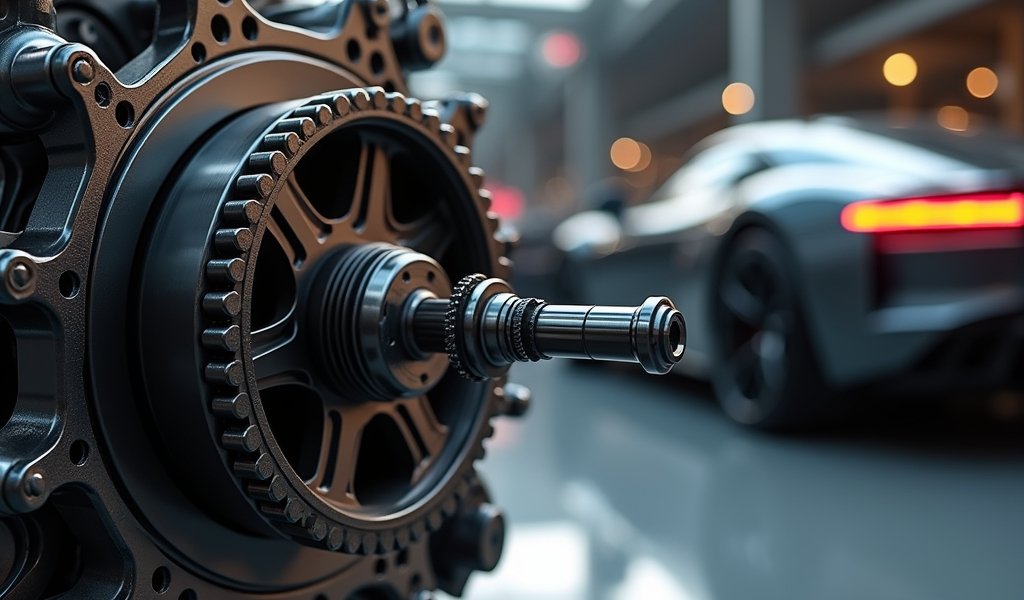Overview
This article identifies five solutions for timing chain stretch: complete replacement, tensioner adjustment, regular oil changes with quality oil, modified driving habits, and preventative maintenance. Early detection of symptoms like engine rattling, poor fuel economy, and rough idling is crucial to prevent catastrophic engine failure, especially in high-risk vehicle models from Volkswagen, GM, BMW, Ford, and Nissan.
Table of Contents
- Understanding Timing Chain Stretch
- Symptoms of Timing Chain Stretch
- Fix #1: Complete Timing Chain Replacement
- Fix #2: Tensioner Adjustment or Replacement
- Fix #3: Regular Oil Changes with Quality Oil
- Fix #4: Adjust Driving Habits
- Fix #5: Preventative Maintenance
- Conclusion
- Frequently Asked Questions
Understanding Timing Chain Stretch
Ever heard that ominous rattle when you start your car on a cold morning? That could be your timing chain crying out for help. Camshaft timing chain stretch isn’t actually “stretching” like a rubber band – it’s wear at the chain’s pin joints that creates excess slack. This slack throws off the precise timing between your crankshaft and camshaft, and trust me, these two need to be in perfect sync.
I’ve seen countless engines damaged because folks ignored early warning signs of timing chain issues. When your engine’s heart gets out of rhythm, it’s only a matter of time before serious problems develop. The good news? You can address this common issue before it leaves you stranded or facing a massive repair bill.
Certain vehicles are more prone to timing chain stretch than others. The usual suspects include some Volkswagen/Audi 2.0T engines, GM’s Ecotec lineup, BMW N20/N26 engines, and various Ford and Nissan models. If you’re driving one of these, consider yourself on notice – preventative care becomes even more crucial.
Symptoms of Timing Chain Stretch
Your engine has its own way of telling you when the timing chain isn’t happy. The most obvious sign is that distinctive rattle or whine during startup that often quiets down as the engine warms and oil pressure builds. Don’t ignore this – it’s like your engine clearing its throat before the real coughing fit begins.
Beyond the noise, watch for these warning flags:
- Check engine light with camshaft timing-related codes
- Poor fuel economy (sometimes dropping 2-3 MPG seemingly overnight)
- Rough idle or hesitation during acceleration
- Misfiring or power loss, especially under load
- Difficulty starting the engine
The tricky part? These symptoms can mimic other issues, which is why many folks misdiagnose timing chain problems until it’s too late. If you’re experiencing several of these symptoms, especially on a higher-mileage vehicle, it’s time for a proper diagnosis from someone who knows what they’re looking for.

Fix #1: Complete Timing Chain Replacement
When timing chain wear becomes significant, there’s only one real solution – replacement. This isn’t just swapping out the chain itself, but typically the whole timing set including guides, tensioners, and sometimes sprockets. Think of it as heart surgery for your engine – invasive but potentially life-saving.
The cost varies widely depending on your vehicle. For a 4-cylinder engine, expect to pay anywhere from $500 to $1,500 at a shop. V6 and V8 engines can climb to $2,000+ because accessing the timing chain often requires removing more components. The parts themselves usually run $200-500, with labor making up the rest.
Is this a DIY job? I wouldn’t recommend it unless you’ve got serious mechanical skills and proper tools. Timing chain replacement requires precise alignment – mess up the timing marks by just one tooth, and you could end up with bent valves or worse. For most folks, this is one job worth paying a professional to handle.
When done correctly, a new timing chain can restore your engine’s performance and eliminate those worrying symptoms. Plus, you’ll likely notice improved fuel economy and smoother operation – the benefits of proper valve timing are immediately noticeable.
Fix #2: Tensioner Adjustment or Replacement
Sometimes the chain itself isn’t the primary culprit – it’s the tensioner that’s failed to keep everything tight. The tensioner’s job is pretty straightforward: maintain proper tension on the chain regardless of operating conditions. When it fails, the chain gets loose, causing that characteristic rattle and allowing timing variations.
On some vehicles, especially older models, tensioners can be adjusted to compensate for minor chain wear. Modern engines typically use hydraulic tensioners that either work properly or need replacement. The good news? Replacing just the tensioner is significantly cheaper than a complete timing chain job – often $200-400 total.
Here’s why tensioner problems are so common: they rely on oil pressure to function. If you’ve been stretching your oil change intervals or running with low oil, your tensioner is likely suffering. Low-quality oil can also gunk up the tensioner’s internal passages, preventing proper operation.
Tensioner replacement difficulty varies widely by engine design. On some cars, it’s relatively accessible. On others, you’ll need to remove multiple components just to reach it. Always consult your vehicle’s service manual or a reputable repair guide before attempting this repair.
Fix #3: Regular Oil Changes with Quality Oil
Think of oil as your timing chain’s lifeblood. Clean, quality oil creates a protective film between metal surfaces, reducing friction and preventing premature wear. When oil gets dirty or breaks down, that protection diminishes, and your timing components start wearing faster than designed.
I can’t emphasize this enough: follow your manufacturer’s recommended oil change intervals, and consider going even more frequent if you have a model prone to timing chain issues. For most vehicles, that means:
- Conventional oil: Every 3,000-5,000 miles
- Synthetic blend: Every 5,000-7,500 miles
- Full synthetic: Every 7,500-10,000 miles
Oil type matters tremendously. Modern engines with timing chains generally benefit from full synthetic oils, which maintain their protective properties longer and flow better during cold starts – when most timing chain wear occurs. Always use the viscosity recommended in your owner’s manual (typically 5W-30 or 0W-20 for newer vehicles).
This preventative approach costs about $50-80 per oil change using quality synthetic oil – a small price compared to timing chain replacement. Think of regular oil changes as cheap insurance for your engine’s timing system.

Fix #4: Adjust Driving Habits
How you drive directly impacts your timing chain’s lifespan. Short trips where the engine never reaches operating temperature are particularly harmful – the oil doesn’t fully circulate and moisture doesn’t evaporate from the crankcase, creating conditions ripe for premature wear.
Cold starts put tremendous strain on your timing components. When you first start your car, especially in cold weather, there’s a brief moment before oil pressure fully builds. During this time, your timing chain is essentially running with minimal lubrication. Letting your engine idle for 30-60 seconds before driving off can make a significant difference in timing chain longevity.
Another habit that hammers timing components? “Lugging” the engine – pushing hard at low RPMs in high gear. This puts excessive strain on the timing chain as it tries to overcome the resistance. Instead, downshift when you need power, letting the engine spin more freely at higher RPMs.
If you’ve already noticed minor timing chain symptoms, modifying your driving style might buy you some time before a major repair is needed. Gentler acceleration, proper warm-up, and avoiding extreme conditions can help manage a timing chain that’s beginning to show signs of wear.
Fix #5: Preventative Maintenance
The cheapest timing chain repair is the one you avoid through proactive maintenance. Beyond oil changes, there are several preventative measures worth considering, especially if your vehicle falls into the high-risk category.
First, have your check engine light diagnosed promptly if it appears. Modern engines use camshaft position sensors to detect timing variations – often catching chain stretch before you notice any drivability issues. These sensors can spot problems developing before they become serious.
Second, consider having your timing chain inspected at major service intervals (60,000-90,000 miles). Many manufacturers don’t specify timing chain replacement as regular maintenance, but a professional can check for excess play or listen for noise that indicates wear.
For vehicles with known timing chain issues, some owners opt for proactive replacement around 100,000 miles, even without symptoms. While this might seem expensive, it’s far cheaper than replacing an engine damaged by a failed timing chain. This is especially true for “interference engines” where valve and piston paths overlap – a timing failure in these engines almost always results in catastrophic damage.
Some manufacturers have extended warranties specifically for timing chain issues. Check if your vehicle is covered under any such program before paying for repairs out-of-pocket.
Conclusion
Camshaft timing chain stretch doesn’t have to spell disaster for your engine or wallet. By understanding the early warning signs and taking proactive steps, you can often address this issue before it leads to major mechanical problems. Remember that your timing system maintenance is critical to your engine’s overall health and longevity.
The five fixes we’ve covered range from preventative measures to complete replacement, giving you options regardless of where you are in the timing chain wear process. For most vehicles, a combination of proper oil maintenance, adjusted driving habits, and regular inspections will keep your timing chain healthy for many miles.
If you’re already experiencing symptoms, don’t delay – what starts as a minor rattle can quickly progress to significant engine damage. A timely repair now could save you thousands down the road. Your engine’s heart deserves proper care, and with these fixes, you can keep it beating smoothly for years to come.
Frequently Asked Questions
How long does a timing chain typically last?
Most timing chains are designed to last the lifetime of the engine, typically 150,000+ miles. However, vehicles with known timing chain issues may experience problems much earlier, sometimes around 60,000-80,000 miles.
Can I drive with a stretched timing chain?
It’s not recommended to drive with a stretched timing chain as it can lead to catastrophic engine damage without warning. The risk increases significantly with each mile driven after symptoms appear.
How much does timing chain replacement cost?
Timing chain replacement typically costs between $500-$2,000 depending on your vehicle make and model. The higher cost applies to luxury vehicles and engines where access is difficult.
What happens if my timing chain breaks while driving?
If your timing chain breaks while driving, your engine will immediately shut down and could suffer severe internal damage. In interference engines, this often means bent valves and possibly damaged pistons, requiring a complete engine rebuild.
Is a timing chain better than a timing belt?
Timing chains typically last longer than timing belts and don’t require scheduled replacement like belts do. However, when chains fail, they often cause more damage and are generally more expensive to replace than belts.

